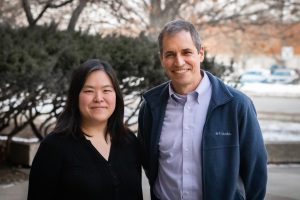Throughout years of floods from natural disasters, research has mostly focused on the impact of dangerous bacteria that are released from municipalities or agricultural fields and swept along in floodwaters. But what happens to the pathogens (contaminants that cause disease) that were released and stick around when the flood waters are no longer there, and how does it impact the communities exposed?
Iowa State University’s Department of Civil, Construction and Environmental Engineering (CCEE) professors Chris Rehmann and Kaoru Ikuma just received a $249,114 award from the Water Resources Research Act Program National Competitive Grants Program to conduct research on this exact question. The CCEE team matched this award with $253,594 from partners and university support.

In three different places in the United States, the team is working with the U.S. Geological Survey team to study where pathogens from flood water end up once the flood water is no longer there and how the places where they stick around correlate with underserved communities.
Across the three locations – Loiza, Puerto Rico; Milwaukee, Wisconsin; and Houston, Texas, there is a history of floods from the coast or great lakes. Along with being located in a flood zone, the three places are also in close proximity to sources of contamination, like wastewater treatment plants or farms. Floods can pick up pathogens from those close-proximity pathogen hotspots and can cause these communities to unfairly face the dangers of pathogen exposure.
Using their research as a part of the road to environmental justice, Rehmann and Ikuma will have created a ‘pathogen hotspot’ map by the end of the project, showing what areas in each location have the most pathogen exposure following a flood.
“What we want to do is have a map of pathogen hotspots, not only during the flood but when the flood recedes,” Ikuma said. “By seeing the aftermath of the flood, we can determine if they stick around, or if they move and have different hotspots.”
After the map is complete, they can compare it to maps showing what communities live in the pathogen hotspots.
“A big theme of this project is environmental justice – which is the idea that no single community should disproportionately bear the burden of contamination,” Rehmann said. “We want to see what makes certain populations in these three areas more vulnerable than others.”
The team is using computational models of flooding events to help understand where sources of pathogens are, and how they will mobilize with flood waters. Using basic principles like conservation of mass and momentum, they can predict where the water will go by simulating the movement. After gathering a general prediction, they can cross-check their results by incorporating past data from previous floods into the model and predict what will happen in other scenarios, also accounting for climate change and other variables.
This data can help determine what the measurable risks are from flooding, who it impacts and what pathogens stick around when flood waters are no longer there.
“When it comes to flooding research, there is a lot of research done on how the water moves, but not what happens to the contaminants that stay behind,” Ikuma said. “Going back to Hurricane Katrina, there were a lot of images of people walking in flooded areas, and every flood there are news articles about people getting infected from bacteria.”
Being exposed to pathogens can cause many health risks, and the maps that the team has looked at show that people of color or lower income communities tend to live in the flood zones that are in close proximity to these pathogens. Having the data from their research will confirm the contamination pathways and address how those areas and communities can be made more resilient to floods and pathogen exposure.
Both Rehmann and Ikuma are passionate about helping underserved communities through this project. Environmental injustice is very prevalent, and having this data can encourage more equitable and resilient infrastructure that will keep the pathogens contained.
“Hopefully this will help people – help the people that have not been helped,” Ikuma said. “Environmental injustice, we don’t want to see, so we are trying to help resolve it.”
